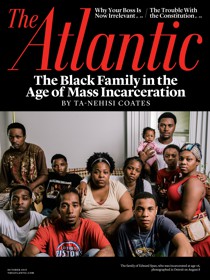The Atlantic
The Decay of Twitter
TECHNOLOGY
The Decay of Twitter
The social network fundamentally changed in early 2014. And that’s causing big problems for the company.

Twitter stock fell more than 10 percent after the announcement.
Since it went public two years ago, investors have rarely considered Twitter’s prospects rosy. The sliver of Twitter’s users who are interested in how it fares as a corporation have gotten used to this, I think: There’s an idea you see floating around that, beyond avoiding bankruptcy, Twitter’s financial success has little bearing on its social utility. Maybe there are only 320 million humans interested in seeing 140-character updates from their friends every day after all. If you make a website that 4 percent of the world’s population finds interesting enough to peek at every month, you shouldn’t exactly feel embarrassed.
Talking about Twitter the Network is hard. I’ve tried it once before, when my colleague Adrienne LaFrance and I tried to describe how English-language, U.S. Twitter of April 2014 differed from the equivalent Twitter of two years prior. Eighteen months on, I think our effort missed a lot. But I do think we noticed that the social network was slipping into something like midlife. It sometimes feels like Instagram, for instance, is the only social network that people actually still love to use.
But I’m still talking in terms of feel: a biased, decidedly non-precise way of discussing something which emerges from more than 300 million minds. And that’s why I like one theory of what’s changed about Twitter from the Canadian academic Bonnie Stewart. I think it makes clear why Twitter the Company is finding such difficulty attracting new users, especially in the United States. And I think it even helps answer the Instagram question, namely: Why is Instagram (or Vine, or Pinterest) so much more fun than Twitter?
* * *
Discussions of Walter Ong always lead off with a litany of job titles. Ong was an English professor and a historian of religion at Saint Louis University. He served as president of the Modern Language Association for a year. He was Marshall McLuhan’s student. And from age 23 to his death in 2003 at 91, he was or was training to be a Jesuit priest.Ong’s great scholarly focus was the transition of human society from orality to literacy: from sharing stories and ideas through spoken language alone, to sharing them through writing, text, and printed media. His work catalogued the many differences between these two cultures: that orality treats words as sound and action, only; that it emphasizes memory and redundancy; that it stays close to the “human lifeworld.” In literate cultures, on the other hand, words are something you look up; language can stray more abstractly from objects; and speech, freed from memorable epithets like “the wine-dark sea,” can become more analytic. (Am I painfully simplifying a great scholar’s work here? Of course.)
Ong advanced this analysis for modern times, as well. To describe oral communication that was filtered through high technologies like radio and TV—technologies that could not exist without literacy—he coined the term secondary orality. To Ong, secondary orality was one of the great media phenomena of the 20th century.
How do you describe this odd mix of registers: literate culture that has all the ephemerality of oral culture? During his life, Ong suggested a new term,secondary literacy. I’ve also seen it referred to as a hybrid literacy. Twitter is a archetypal example of this type. Though “conceived as a simulation of face-to-face communication,” writes one scholar, Twitter lets users read the same words at different times, which is a key aspect of literacy. Tweets are chatty, fusing word and action like orality; and also declarative, severable, preservable, and analyzable like literacy.
And now we get to Bonnie Stewart. Stewart studies Academic Twitter in particular, though her ideas, I think, have broader application. I first saw her writing in September 2014; she expanded them in April of this year in a reflection on a huge scholarly Twitter battle over tenure.
The sense of participatory collective—always fraught—has waned as more and more subcultures are crammed and collapsed into a common, traceable, searchable medium. We hang over each other’sheads, more and more heavily, self-appointed swords of Damocles waiting with baited breath to strike.
And what has specifically gotten pressed is the balance of spoken-word habits and written-word ones. “The rot we’re seeing in Twitter is the rot of participatory media devolved into competitive spheres where the collective ‘we’ treats conversational contributions as fixed print-like identity claims,” she writes.
In other words, on Twitter, people say things that they think of as ephemeral and chatty. Their utterances are then treated as unequivocal political statements by people outside the conversation. Because there’s a kind of sensationalistic value in interpreting someone’s chattiness in partisan terms, tweets “are taken up as magnum opi to be leapt upon and eviscerated, not only by ideological opponents or threatened employers but by in-network peers.”I think Stewart is identifying a new facet of this. It’s not quite context collapse, because what’s collapsing aren’t audiences so much as expectations. Rather, it’s a collapse of speech-based expectations and print-based interpretations. It’s a consequence of the oral-literate hybrid that flourishes online. It’s conversation smoosh.
* * *
What I like about Stewart’s work isn’t just that she identifies this mechanic. She can say that conversation smoosh (which, to be very clear here, is my term) is a force shaping the network without conceding it’s entirely a bad thing. As she writes:Twitter, dead or no, is still a powerful and as yet unsurpassed platform for raising issues and calling out uncomfortable truths, as shown in itsamplification of the #Ferguson protests to media visibility (in a wayFacebook absolutely failed to do thanks to the aforementioned algorithmic filters). Twitter is, as my research continues to show, a path to voice.Stewart calls the ability for marginalized groups to seize the mic “tactical Twitter.” (This is a way, way better term than “Twitter shaming,” which is whatJon Ronson and many others previously preferred to call the effect.) Tactical Twitter has aided civil-rights movements and neofascistic ones. And the media intensifies Tactical Twitter by watching Twitter as a social network more closely than it does other sites—what happens there gets turned into news stories in a way that doesn’t happen in other places.
At the same time, Twitter is also a free soapbox for all kinds of shitty and hateful statements that minimize or reinforce marginalization, as any woman or person of colour who’s dared to speak openly about the raw deal of power relations in society will likely attest. And calls for civility will do nothing except reinforce a respectability politics of victim-blaming within networks.
This tension also explains, to me, why the more visual social networks have stayed fun and vibrant even as the text-based ones have not. Vine, Pinterest, and Instagram don’t traffic in words, which can be reduced to identity-based magnum opi, but in images, which are a little harder to smoosh. Visual conversations have stayed chatty, in other words.
When I emailed Stewart to ask about these ideas, though, she wasn’t as sure.
“I think that has as much to do with cultural norms of the platforms and particularly with media usage/surveillance of the platforms,” she said. “I’m not sure Twitter’s volatility is inherent to Twitter’s use of the written word so much as it's how Twitter relates to the written word.”
She continued:
I think visibility has a lot to do with it. Media surveillance of Twitter to create (not just disseminate) news, the way hashtags allow strangers to gather and galvanize over areas of shared interest, the fact that the stream or feed is made up of a constant flow of discrete speech acts with limited context […]—all these things made it feel like a powder keg in hot weather a year ago.In the final paragraphs of this article, let me assert something I have very little data to support: At some point early last year, the standard knock against Twitter—which had long ceased to be “I don’t want to know what someone’s eating for lunch”—became “I don’t want everyone to see what I have to say.” The public knows about conversation smoosh, and that constitutes, I think, a major problem for Twitter the Company. New products like Moments—which collects tweets, images, and video into little summaries—are not going to fix that.
Now, it’s just Twitter. It’s a space where all contexts are collapsed and all ideas can be mob-amplified or end up pulled for a Buzzfeed article. And I’ve adjusted accordingly and I am careful about what I say and some of that is good because frankly the world does not need to hear me pronounce on every single thing I don’t know much about. Twitter’s affordances still render it powerful—but that very power and capacity to curry visibility, both within its own space and within broader media spaces, also render it challenging.
I’m not sure anything can fix it, honestly. But I wonder if Twitter can’t arrange a de-smooshing, at least a little bit, by creating more forms of private-ness on the site. Separating the private and the public could, in turn, delineate “speech-like” and “print-like” tweets. Twitter’s offered locked accounts for a long time, but it has always been default public. (For a few early years, a pane on Twitter.com displayed every tweet.) Making it so an individual tweet’s publicness can be toggled on or off might help users feel more comfortable spending time there. And pushing new users toward secret accounts that can toggle individual tweets public might even allay some of their fears.
Or maybe nothing can be done. No one promises growth forever. Communities and companies of all sizes fall apart. And some institutions that thrive on their tensions for many years can one day find them exhausted, worn out, limp, their continued use driven more by convenience and habit than by vibrancy and vigor.




No comments:
Post a Comment
Please leave a comment-- or suggestions, particularly of topics and places you'd like to see covered